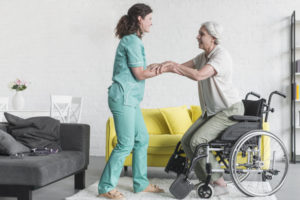Spine Balance & Strength in Older Patients
 Each year, more than 1.6 million older U.S. adults go to emergency departments for fall-related injuries. Among older adults, falls are the number one cause of fractures, hospital admissions for trauma, loss of independence and injury deaths. As we get older, it becomes important to improve spine balance and strength to help combat the negative effects of aging. Slower reflexes, muscle weakness and poor balance are all examples of common aging effects that can put us at higher risk of injury like falling.
Each year, more than 1.6 million older U.S. adults go to emergency departments for fall-related injuries. Among older adults, falls are the number one cause of fractures, hospital admissions for trauma, loss of independence and injury deaths. As we get older, it becomes important to improve spine balance and strength to help combat the negative effects of aging. Slower reflexes, muscle weakness and poor balance are all examples of common aging effects that can put us at higher risk of injury like falling.
Improving Spine Balance
When we work with spine balance, one of our main goals is to reduce falling for patients. Older adults, who have poor balance or difficulty walking, are more likely than others to fall. Poor spine balance may be related to a lack of exercise or to a neurological cause, arthritis, or other medical conditions. Using specifically designed workouts will strengthen the muscles around the spine and ultimately improve balance in the process.
Over time, issues related to reflexes and sensory skills may also lead to spine balance problems and ultimately, more falls. As you get older, the amount of time it takes for you to react may make it harder to catch your balance if you start to fall. If your senses don’t work well, you might be less aware of your environment. Neuropathy, or having numbness in your feet, may cause you to be less aware of where you are stepping.
Improving Spine Strength
 At Ability Rehabilitation, we have designed specific exercise programs to increase the strength of the base of the spine and make it easier to perform movements such as standing up from a chair, getting in and out of a car, and increase overall balance during walking. This helps to minimize the use of walkers or canes and making sure you’re saying while performing these activities.
At Ability Rehabilitation, we have designed specific exercise programs to increase the strength of the base of the spine and make it easier to perform movements such as standing up from a chair, getting in and out of a car, and increase overall balance during walking. This helps to minimize the use of walkers or canes and making sure you’re saying while performing these activities.
Have any questions? Call the clinic closest to your location
or click here to schedule your appointment now. No referral needed!
